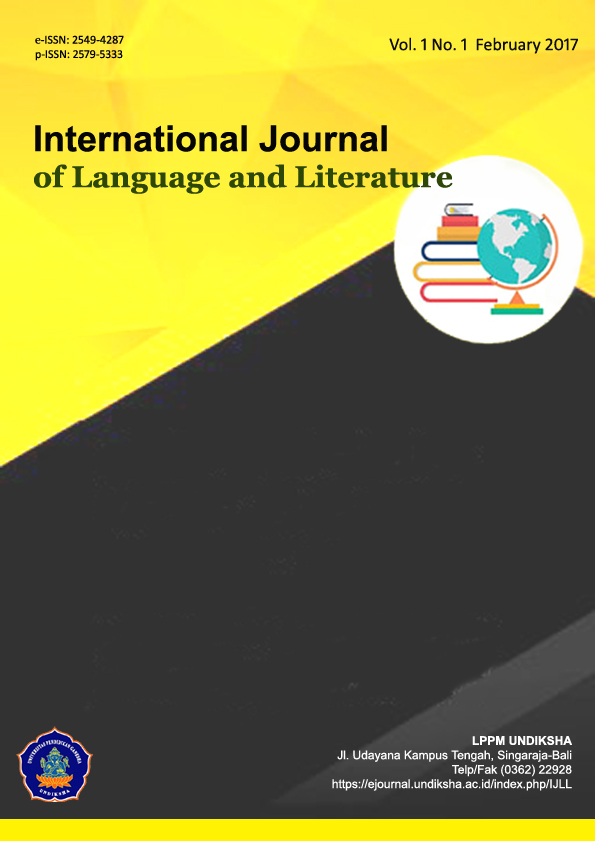SELF-DIRECTED LEARNING IN EFL DURING COVID-19 PANDEMIC: AN ANALYSIS OF TEACHER’S PERCEPTIONS AND STUDENTS’ LEARNING AUTONOMY
DOI:
https://doi.org/10.23887/ijll.v5i2.31974Keywords:
self-directed learning, teacher’s perception, online learning, learning autonomy, students’ activitiesAbstract
The focus of this research was to analyze the teacher's perception of self-directed learning, to observe activities assigned by the teacher in implementing self-directed learning, and to identify self-directed learning components from the activities assigned by the teacher. The embedded mixed-method was used as a design in which the more dominant was qualitative data rather than quantitative data. SMA Negeri 4 Singaraja was chosen as the research setting and one English teacher who teaches in the tenth-grade at this school was chosen as the subject in this study. The researcher, self-rated questionnaire, observation table, and identification table were used as instruments in this research. The self-rated questionnaire showed that the teacher-rated himself to have high knowledge of self-directed learning but in fact, the observation shows that the teacher was not able to implement well that knowledge into online learning. The data showed the mismatch between teacher perception and activities of self-directed learning assigned to students in online learning.
References
A Tjakradidjaja, F., Prabandari, Y. S., Prihatiningsih, T. S., & Harsono, H. (2016). The Role of teacher in medical student self-directed learning process. Journal of Education and Learning (EduLearn), 10(1), 78. https://doi.org/10.11591/edulearn.v10i1.2992 DOI: https://doi.org/10.11591/edulearn.v10i1.2992
Agustiani, I. W. D. (2019). Maximazing Teacher Roles in Shaping Self-Directed Learners. English Community Journal, 3(1), 289. https://doi.org/10.32502/ecj.v3i1.1694 DOI: https://doi.org/10.32502/ecj.v3i1.1694
Bedir, H. (2019). Pre-service ELT teachers’ beliefs and perceptions on 21st century learning and innovation skills (4Cs). Journal of Language and Linguistic Studies, 15(1), 231–246. https://doi.org/10.17263/jlls.547718 DOI: https://doi.org/10.17263/jlls.547718
Bravo, J. C., Intriago, E. A., Holguin, J. V., Garzon, G. M., & Arcia, L. O. (2017). Motivation and Autonomy in Learning English as Foreign Language: A Case Study of Ecuadorian College Students. English Language Teaching, 10(2), 100. https://doi.org/10.5539/elt.v10n2p100 DOI: https://doi.org/10.5539/elt.v10n2p100
Cakici, D. (2015). Autonomy in Language Teaching and Learning Process. İnönü Üniversitesi Eğitim Fakültesi Dergisi, 16(1). https://doi.org/10.17679/iuefd.16168538 DOI: https://doi.org/10.17679/iuefd.16168538
Creswell, J. W. (2014). Research design: Qualitative, quantitative, and mixed method approaches. London, Los Angeles, Calif: Sage.
Gulchekhra, K. (2016). Benefits of Implementation of Pre- While and Post Reading Activities in Language Learning. International Journal of Science, 1(4), 45–46.
Han, L. (2020). On the Relationship Between Teacher Autonomy and Learner Autonomy. International Education Studies, 13(6), 153. https://doi.org/10.5539/ies.v13n6p153 DOI: https://doi.org/10.5539/ies.v13n6p153
Humaira, S. A., & Hurriyah, I. A. (2018). Students ’ perspectives towards self-directed learning out of classroom. International Conference on English Language Teaching (ICONELT 2017), 145, 7–11. https://doi.org/10.2991/iconelt-17.2018.2 DOI: https://doi.org/10.2991/iconelt-17.2018.2
Khodabandehlou, M., Jahandar, S., Seyedi, G., Mousavi, R., & Abadi, D. (2014). The Impact of Self-directed Learning Strategies on Reading Comprehension. (May).
Khotimah, K., Widiati, U., Mustofa, M., & Ubaidillah, M. F. (2019). Autonomous English learning : Teache rs ’ and students ’ perceptions. (October). https://doi.org/10.17509/ijal.v9i2.20234 DOI: https://doi.org/10.17509/ijal.v9i2.20234
Kumbakonam, U. R. (2017). ROLE OF A TEACHER IN ENGLISH LANGUAGE TEACHING ( ELT ). (January).
Kurdi, F. N. (2009). Penerapan Student Centered Learning dari Teacher Centered Learning Mata Ajar Ilmu Kesehatan pada Program Studi Penjaskes. Forum Kependidikan, 28(2), 108–113.
Little, D. (1991). Learner autonomy (2nd ed.; Jean, ed.). Dublin: Authentik Language Learning Resources Ltd.
Masouleh, N. S., & Jooneghani, R. B. (2012). Autonomous learning: A teacher-less learning! Procedia - Social and Behavioral Sciences, 55, 835–842. https://doi.org/10.1016/j.sbspro.2012.09.570 DOI: https://doi.org/10.1016/j.sbspro.2012.09.570
Morris, T. H. (2019). Self-directed learning: A fundamental competence in a rapidly changing world. International Review of Education, 65(4), 633–653. https://doi.org/10.1007/s11159-019-09793-2 DOI: https://doi.org/10.1007/s11159-019-09793-2
Ningrum, E. S., & Sobri, A. Y. (2015). Implementasi kurikulum 2013 di sekolah dasar. MNAJEMEN PENDIDIKAN, 24(5), 416–423.
Nurbaidah. (2019). Teaching Strategy Implemented by an English Teacher in Teaching Reading To Eleventh Grade Students at Smk Bhakti Mulia Pare in Academic Year 2017/2018.
Porter, B. D., & Freeman, M. K. (2020). Experienced Outcomes of a Self-Directed Professional Development Program. 4(1).
Puspitasari, E. (2020). Teacher ’ s belief about the implementation of curriculum 2013 in English language. Ethical Lingua, 7(1), 101–111. https://doi.org/10.30605/25409190.171 DOI: https://doi.org/10.30605/25409190.171
Salkhanova, Z. H., Lee, V. S., Tumanova, A. B., & Zhusanbaeva, A. T. (2016). The subject-object approach as a direction of the learning theory in the context of modern linguistic education paradigms. International Journal of Environmental and Science Education, 11(10), 3730–3745.
Salleh, U. K. M., Zulnaidi, H., Rahim, S. S. A., Zakaria, A. R. Bin, & Hidayat, R. (2019). Roles of self-directed learning and social networking sites in lifelong learning. International Journal of Instruction, 12(4), 167–182. https://doi.org/10.29333/iji.2019.12411a DOI: https://doi.org/10.29333/iji.2019.12411a
Sugiyono. (2015). Metode Penelitian Pendidikan (Pendekatan Kuantitatif, Kualitatif dan R&D).
Swatevacharkul, R., & Boonma, N. (2020). Learner autonomy: Attitudes of graduate students in English language teaching program in Thailand. LEARN Journal: Language Education and Acquisition Research Network, 13(2), 176–193.
Syah, R. H. (2020). Dampak Covid-19 pada Pendidikan di Indonesia: Sekolah, Keterampilan, dan Proses Pembelajaran. SALAM: Jurnal Sosial Dan Budaya Syar-I, 7(5). https://doi.org/10.15408/sjsbs.v7i5.15314 DOI: https://doi.org/10.15408/sjsbs.v7i5.15314
Tan, L., & Ling, J. K. H. (2014). Self-Directed Learning : Learning in the 21st Century. Singapure Ministry of Education.
Turan, M. B., & Koç, K. (2018). The impact of self-directed learning readiness on critical thinking and self-efficacy among the students of the school of physical education and sports. International Journal of Higher Education, 7(6), 98–105. https://doi.org/10.5430/ijhe.v7n6p98 DOI: https://doi.org/10.5430/ijhe.v7n6p98
Yu, T. X., & Wan Mohammad, W. M. R. (2019). Integration of 21st Century Learning Skills (4C Elements) in Interventions to Improve English Writing Skill Among 3K Class Students. International Journal of Contemporary Education, 2(2), 100. https://doi.org/10.11114/ijce.v2i2.4498 DOI: https://doi.org/10.11114/ijce.v2i2.4498
Zakareya, S., & Al-Qahtani, F. (2020). The Effect of Webfolios on Saudi EFL Students’ Self-Directed Learning Readiness. International Education Studies, 13(5), 150. https://doi.org/10.5539/ies.v13n5p150 DOI: https://doi.org/10.5539/ies.v13n5p150
Downloads
Published
How to Cite
Issue
Section
License
IJLL Journal provides immediate open access to its content on the principle that making research freely available to the public to supports a greater global exchange of knowledge.

This work is licensed under a Creative Commons Attribution-ShareAlike 4.0 International License







